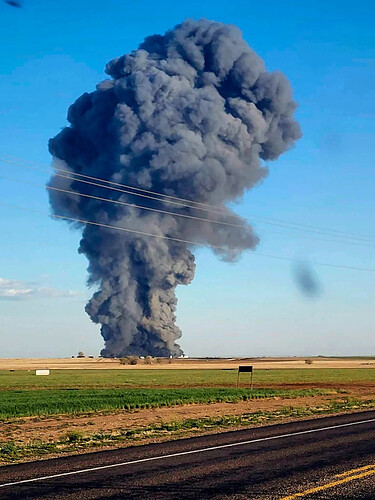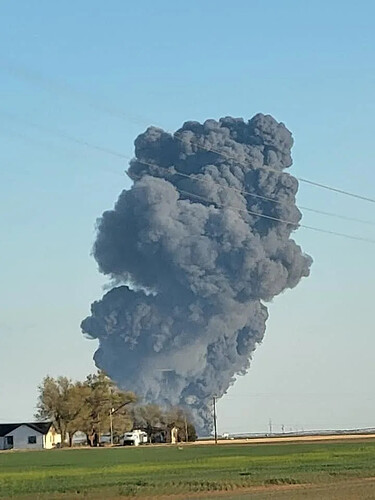18,000 cows killed in Texas explosion. Next: The massive, messy task of disposing of them
1.8k
Rick Jervis, USA TODAY
Fri, April 14, 2023 at 10:49 PM CDT
The fire that killed 18,000 dairy cows in a West Texas farm has been extinguished and the staggering death count revealed.
Now, comes the messy, unprecedented task of disposing of them.
Typically, dead farm animals – even scores of them, such as those killed in the wake of hurricanes or blizzards – can be buried, hauled to landfills or even composted, said Saqib Mukhtar, an associate dean at the University of Florida’s Institute of Food and Agricultural Sciences Extension and a cattle disposal expert.
But the sheer number of carcasses in this incident makes the task monumental, he said.
“I really don’t know, if [the cows] were all intact, how in the world you can manage this even within a month,” said Mukhtar, who previously worked at Texas A&M University and helped dispose of thousands of cattle drowned by Hurricane Ike in 2008.
Smoke fills the sky after an explosion and fire at the South Fork Dairy farm near Dimmitt, Texas, on Monday, April 10, 2023. The explosion critically injured one person and killed an estimated 18,000 cows.
More: 18,000 cows killed in explosion, fire at Texas dairy farm may be largest cattle killing ever
Officials have not said what method of disposal they will use in the case of the South Fork farm disaster.
Video footage from local television stations showed front-loaders entering and exiting the pens where an estimated 18,000 cattle – a mix of Holstein and Jersey cows – perished during a fire Monday evening at the South Fork Dairy farm near Dimmitt, Texas, around 70 miles southwest of Amarillo.
A dairy worker was rescued from inside the facility and rushed to a hospital. She was in critical condition as of Tuesday.
Special report: 10 years after tragic Texas chemical explosion, risk remains high
Dealing with cattle deaths in Texas
While state fire investigators look into the cause of the blaze, officials with the Texas Commission on Environmental Quality and Texas A&M AgriLife Extension Service have descended onto the scene to advise and monitor the disposal of the animals.
In a statement, TCEQ said its Amarillo office “is providing assistance to South Fork Dairy to ensure that dead livestock and any other debris is disposed of in accordance with TCEQ rules and regulations,” including ensuring the animals are buried at least 50 feet from the nearest public water well and outside the 100-year floodplain.
On its website, TCEQ lists more than 13 rules surrounding the disposal of livestock carcasses, including making sure they’re buried in at least three feet of soil, and covered as soon as possible, “ideally the same day.”
The incident could also draw agents from the U.S. Department of Agriculture’s Animal and Plant Health Inspection Service, as well as scientists with the Environmental Protection Agency – all monitoring how the dead animals may contaminate soil, air or aquifers, said Andy Vestal, a retired professor and extension specialist at Texas A&M AgriLife Extension Service who has assisted in large-scale cattle disposal. The efforts are aimed at protecting both humans and livestock, he said.
“You have an element of human public health and livestock sustainability to deal with,” Vestal said.
Graphics: 18,000 cows – enough to cover 26 football fields
How many cattle were killed in the fire?
The Castro County Sheriff’s Office was among several agencies to respond to a fire and explosion at a dairy farm near Dimmitt on Monday.
The fire was the deadliest involving cattle recorded by the Animal Welfare Institute since it began tracking barn and animal pen fires in 2013.
Overall, the group has tracked 6.5 million animals killed in fires in that span, with chickens making up more than 90% of the fatalities. This week, the number of cattle herd killed by fires jumped from 7,385 to 25,385, after the institute added the South Fork incident.
Who owned the Texas dairy company?
State records show the South Fork Dairy farm was owned by the Brand family. Frank Brand did not return several requests for comment. A neighbor told the industry publication Dairy Herd that the Brand family was "a great family and customer, and said the community supported them.
Dimmitt Mayor Roger Malone told USA TODAY the dairy had opened in the area just over three years ago and employed 50 to 60 people.
Rules about cattle, farm animals
The incident has drawn the ire from animal activists, who have lobbied for more fire regulations at large-scale farms such as the South Fork Dairy.
Farmers and cattle raisers are not required to abide by the same fire codes or animal welfare rules as zoos and aquariums, creating disparities in treatment, said Allie Granger, a policy associate with the Animal Welfare Institute.
“There’s a huge gap in protection when it comes to animals used for agriculture,” she said.
Though there are rules for disposing carcasses, having such a large number makes the job formidable, said Mukhtar, who co-wrote a widely-used handbook on cattle disposal.
A cowboy attempts to round up cattle from receding flood waters Sept. 15, 2008, Near High Island, Texas, after Hurricane Ike. Saqib Mukhtar, an academic and expert in cattle disposal, helped dispose of thousands of cattle drowned by Hurricane Ike in 2008.
The preferred method is often taking them to a landfill that accepts animal carcasses, which are often engineered to protect the environment from the waste. But hauling so many dead cows to landfalls would be time-consuming, costly and unrealistic, he said.
Burning the carcasses would take too long since you could only burn three or four cows at a time using mobile incinerators, Mukhtar said. And composting would require an unfathomable amount of organic material – such as hay mixed with manure – to cover all 18,000 animals.
Burying them on site, though the least-recommended option because of the risks of pollutants seeping into the soil and aquifer, is the most likely outcome in the South Fork farm case, he said. The main risk with this method is what’s known as “leachate,” or liquids that eventually seep out of the carcasses and into the surrounding soil.
Whatever method is chosen, owners and regulators will need to act fast: As they decompose, cow carcasses release gasses, such as hydrogen sulfide and ammonia, that – if leaked in large enough quantities – could pose air pollution risks, Mukhtar said.
But nothing about disposing of 18,000 carcasses promises to be fast.
“It’s a major, complex conundrum that they’re in,” he said.
Follow Jervis on Twitter: @MrRJervis.
This article originally appeared on USA TODAY: After cattle deaths at Texas dairy: Disposing of 18,000 carcasses




